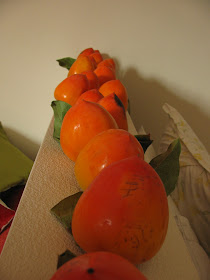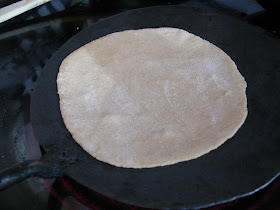It is persimmons season in California. There are two varieties: Hachiya and Fuyu. The Fuyu variety shaped like a flat apple, can be eaten while it is firm, and has a crunchy texture. Look for fruit that is uniformly orange and there are no black spots indicating sun burn.The Hachiya variety is shaped like a tear drop, these need to be allowed to ripen on the counter until they are soft like a jelly. They are amazingly sweet and addictive. Persimmons are loaded with Vitamin A, one medium size persimmon contains about 50% of daily Vitamin A requirement; they are also high in Vitamin C and fiber.
Hachiya on the left and Fuyu on the right.
Stash of Persimmons that I am allowing to ripen! I bought a stash of 20 lbs from someone who has a huge Persimmon tree in their backyard, I couldn't buy a better quality fruit even at the local farmer's market.
A common source of confusion when it comes with Hachiya variety is when is it ready to eat. The key is to let it ripen to the point that it feels like jello. I have added a picture below to show you how the surface should feel. You will notice that when I press it with my fingers it creates a depression and you can see wrinkles on the surface. This persimmon is ready to be eaten, if you don't allow it to full ripen it will have a chalky flavor that will dry your mouth, which is not a very pleasant experience.
Hachiya on the left and Fuyu on the right.
Stash of Persimmons that I am allowing to ripen! I bought a stash of 20 lbs from someone who has a huge Persimmon tree in their backyard, I couldn't buy a better quality fruit even at the local farmer's market.
A common source of confusion when it comes with Hachiya variety is when is it ready to eat. The key is to let it ripen to the point that it feels like jello. I have added a picture below to show you how the surface should feel. You will notice that when I press it with my fingers it creates a depression and you can see wrinkles on the surface. This persimmon is ready to be eaten, if you don't allow it to full ripen it will have a chalky flavor that will dry your mouth, which is not a very pleasant experience.

















